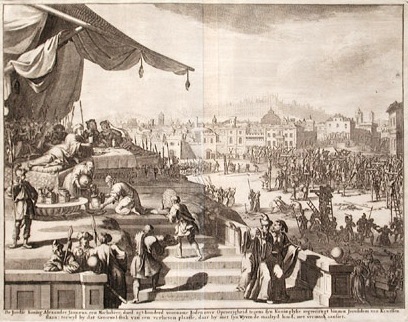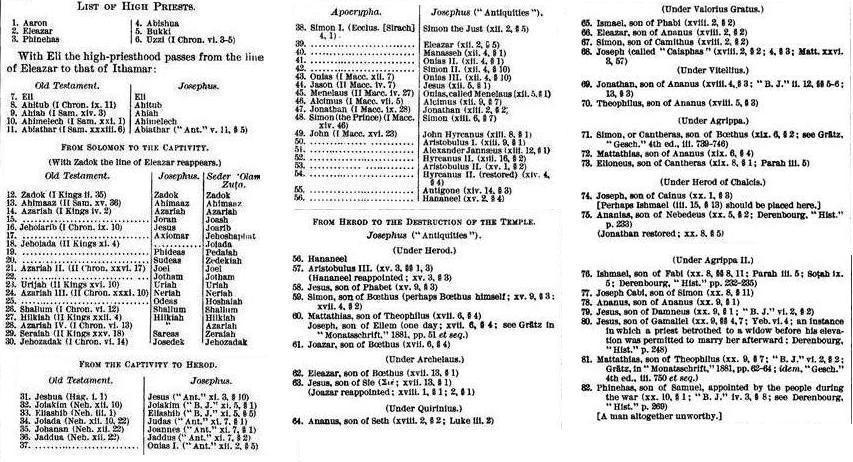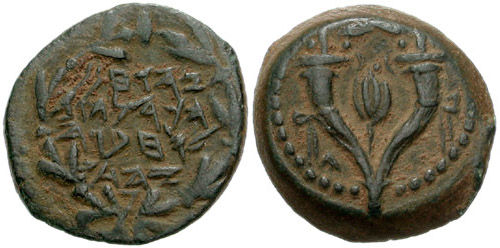|
Jannaeus
Alexander Jannaeus ( grc-gre, Ἀλέξανδρος Ἰανναῖος ; he, ''Yannaʾy''; born Jonathan ) was the second king of the Hasmonean dynasty, who ruled over an expanding kingdom of Judea from 103 to 76 BCE. A son of John Hyrcanus, he inherited the throne from his brother Aristobulus I, and married his brother's widow, Queen Salome Alexandra. From his conquests to expand the kingdom to a bloody civil war, Alexander's reign has been generalised as cruel and oppressive with never-ending conflict. The major historical sources of Alexander's life are Josephus's ''Antiquities of the Jews'' and ''The Jewish War''. The kingdom of Alexander Jannaeus was the largest and strongest known Jewish State outside of biblical sources, having conquered most of Palestine's Mediterranean coastline and regions surrounding the Jordan River. Alexander also had many of his subjects killed for their disapproval of his handling of state affairs. Due to his territorial expansion and interaction ... [...More Info...] [...Related Items...] OR: [Wikipedia] [Google] [Baidu] |
Hasmonean Dynasty
The Hasmonean dynasty (; he, ''Ḥašmōnaʾīm'') was a ruling dynasty of Judea and surrounding regions during classical antiquity, from BCE to 37 BCE. Between and BCE the dynasty ruled Judea semi-autonomously in the Seleucid Empire, and from roughly 110 BCE, with the empire disintegrating, Judea gained further autonomy and expanded into the neighboring regions of Perea, Samaria, Idumea, Galilee, and Iturea. Some modern scholars regard the Hasmonean realm as an independent Israel. The Hasmonean rulers took the Greek title '' basileus'' ("king" or "emperor"). Forces of the Roman Republic conquered the Hasmonean kingdom in 63 BCE and made it into a client state; Herod the Great displaced the last reigning Hasmonean client-ruler in 37 BCE. Simon Thassi established the dynasty in 141 BCE, two decades after his brother Judas Maccabeus ( ''Yehudah HaMakabi'') had defeated the Seleucid army during the Maccabean Revolt of 167 to 141 BCE. According to 1 Maccabees, 2 Maccabee ... [...More Info...] [...Related Items...] OR: [Wikipedia] [Google] [Baidu] |
Salome Alexandra
Salome Alexandra, or Shlomtzion ( grc-gre, Σαλώμη Ἀλεξάνδρα; he, , ''Šəlōmṣīyyōn''; 141–67 BCE), was one of three women to rule over Judea, the other two being Athaliah and Devora. The wife of Aristobulus I, and afterward of Alexander Jannaeus, she was the last regnant queen of Judea, and the last ruler of Judea to die as the sovereign of an independent kingdom. Family Salome Alexandra's personal genealogy is not given by Josephus, nor does it appear in any of the books of Maccabees. Rabbinical sources designate the rabbi, Simeon ben Shetah, as her brother, making her the daughter of Shetah as well. Salome Alexandra's oldest son by Alexander Jannaeus was Hyrcanus II who fought his younger brother Aristobulus II in 73 BCE over the Jewish High Priesthood. Hyrcanus II was eventually successful after enlisting the help of the Nabataean king, Aretas III; bribing Roman officials, including Scaurus; and gaining the favour of Pompey the Great, who defeate ... [...More Info...] [...Related Items...] OR: [Wikipedia] [Google] [Baidu] |
Aristobulus I
Judah Aristobulus I or Aristobulus I (; el, Ἀριστόβουλος, Aristóboulos) was the first Hasmonean king of Judaea from 104 BCE until his death in 103 BCE. He was the eldest of the five sons of John Hyrcanus, the previous leader. Josephus states that he was the first Jew in "four hundred and eighty three years and three months" to have established a monarchy since the return from the Babylonian Captivity. Aristobulus was not only the first king from the Hasmonean lineage, but the first of any Hebrew king to claim both the high priesthood and kingship title. The Sadducees and the Essenes were not concerned about Aristobulus taking the title of king, but the Pharisees were infuriated; They felt that the kingship could only be held by the descendants of the Davidic line. The Pharisees began a massive rebellion, but Aristobulus died before any attempt to depose of him could occur. The major historical sources of his life are Josephus's ''Wars of the Jews'' and '' Antiqu ... [...More Info...] [...Related Items...] OR: [Wikipedia] [Google] [Baidu] |
Hyrcanus II
John Hyrcanus II (, ''Yohanan Hurqanos'') (died 30 BCE), a member of the Hasmonean dynasty, was for a long time the Jewish High Priest in the 1st century BCE. He was also briefly King of Judea 67–66 BCE and then the ethnarch (ruler) of Judea, probably over the period 47–40 BCE. Accession Hyrcanus was the eldest son of Alexander Jannaeus, King and High Priest, and Alexandra Salome. After the death of Alexander in 76 BCE, his widow succeeded to the rule of Judea and installed her elder son Hyrcanus as High Priest. Alexander had numerous conflicts with the Pharisees. However Hyrcanus was supported by the Pharisees, especially later in his tenure. When Salome died in 67 BCE, she named Hyrcanus as her successor as ruler of Judea as well, but soon he and his younger brother, Aristobulus II, dissented over the right to the throne. Deposition Hyrcanus had scarcely reigned three months when Aristobulus II rose in rebellion. Hyrcanus advanced against him at the head of hi ... [...More Info...] [...Related Items...] OR: [Wikipedia] [Google] [Baidu] |
Aristobulus II
Aristobulus II (, grc, Ἀριστόβουλος ''Aristóboulos'') was the Jewish High Priest and King of Judea, 66 BCE to 63 BCE, from the Hasmonean dynasty. Family Aristobulus was the younger son of Alexander Jannaeus, King and High Priest, and Salome Alexandra. After the death of Alexander in 76 BCE, his widow succeeded to the rule of Judea and installed her elder son Hyrcanus II as High Priest in 73 BCE. When Salome died in 67 BCE, Hyrcanus succeeded to the kingship as well. Aristobulus shared his late father's views on religion and politics. He entertained designs upon the throne, even during the life of his mother. He courted the nobles and military party by constituting himself the patron of the Sadducees and bringing their cause before the queen. The many fortresses which the queen placed at the disposal of the Sadducees, ostensibly for their defense against the Pharisees, constituted in reality one of the preparatory moves of Aristobulus for the usurpation of the go ... [...More Info...] [...Related Items...] OR: [Wikipedia] [Google] [Baidu] |
List Of High Priests Of Israel
This article gives a list of the High Priests (''Kohen Gadol'') of Ancient Israel up to the destruction of the Second Temple in 70 AD. Because of a lack of historical data, this list is incomplete and there may be gaps. High Priests of Israel The High Priests, like all Levitical priests, belonged to the Aaronic line. The Bible mentions the majority of high priests before the Babylonian captivity, but does not give a complete list of office holders. Lists would be based on various historical sources. In several periods of gentile rule, high priests were appointed and removed by kings. Still, most high priests came from the Aaronic line. One exception is Menelaus, who may not have been from the Tribe of Levi at all, but from the Tribe of Benjamin. From the Exodus to Solomon's Temple The following section is based on information found in the various books of the Bible, including the genealogies given in First Book of Chronicles and the Book of Ezra, the works of Josephus and ... [...More Info...] [...Related Items...] OR: [Wikipedia] [Google] [Baidu] |
Pharisee
The Pharisees (; he, פְּרוּשִׁים, Pərūšīm) were a Jewish social movement and a school of thought in the Levant during the time of Second Temple Judaism. After the destruction of the Second Temple in 70 CE, Pharisaic beliefs became the foundational, liturgical, and ritualistic basis for Rabbinic Judaism. Conflicts between Pharisees and Sadducees took place in the context of much broader and longstanding social and religious conflicts among Jews, made worse by the Roman conquest. One conflict was cultural, between those who favored Hellenization (the Sadducees) and those who resisted it (the Pharisees). Another was juridical-religious, between those who emphasized the importance of the Temple with its rites and services, and those who emphasized the importance of other Mosaic Laws. A specifically religious point of conflict involved different interpretations of the Torah and how to apply it to current Jewish life, with Sadducees recognizing only the Written Torah ... [...More Info...] [...Related Items...] OR: [Wikipedia] [Google] [Baidu] |
Pharisaic
The Pharisees (; he, פְּרוּשִׁים, Pərūšīm) were a Jewish social movement and a school of thought in the Levant during the time of Second Temple Judaism. After the destruction of the Second Temple in 70 CE, Pharisaic beliefs became the foundational, liturgical, and ritualistic basis for Rabbinic Judaism. Conflicts between Pharisees and Sadducees took place in the context of much broader and longstanding social and religious conflicts among Jews, made worse by the Roman conquest. One conflict was cultural, between those who favored Hellenization (the Sadducees) and those who resisted it (the Pharisees). Another was juridical-religious, between those who emphasized the importance of the Temple with its rites and services, and those who emphasized the importance of other Mosaic Laws. A specifically religious point of conflict involved different interpretations of the Torah and how to apply it to current Jewish life, with Sadducees recognizing only the Written Torah ... [...More Info...] [...Related Items...] OR: [Wikipedia] [Google] [Baidu] |
Simeon Ben Shetach
Simeon ben Shetach, or Shimon ben Shetach or Shatach (), ''circa'' 140-60 BCE, was a Pharisee scholar and Nasi of the Sanhedrin during the reigns of Alexander Jannæus (c. 103-76 BCE) and his successor, Queen Salome Alexandra (c. 76-67 BCE), who was Simeon's sister. He was therefore closely connected with the court, enjoying, at least initially, the favor of Alexander. Although a rabbi by profession, the omission of such an epithet when referred to in rabbinic literature is said to attest to his greatness as a rabbinic Sage, ranking with Hillel. The Shim'on ben Shatah Street in the center of Jerusalem carries his name. Under Alexander Jannaeus During the reign of Alexander the Sanhedrin consisted almost entirely of Sadducees; nevertheless Simeon succeeded in ousting some of the Sadducean members and in replacing them with Pharisees. Having accomplished this, Simeon recalled from Alexandria, Egypt the Pharisees who had been compelled to seek refuge there during the reign of Alex ... [...More Info...] [...Related Items...] OR: [Wikipedia] [Google] [Baidu] |
Sadducees
The Sadducees (; he, צְדוּקִים, Ṣədūqīm) were a socio-religious sect of Jewish people who were active in Judea during the Second Temple period, from the second century BCE through the destruction of the Temple in 70 CE. The Sadducees are often compared to other contemporaneous sects, including the Pharisees and the Essenes. Josephus, writing at the end of the 1st century CE, associates the sect with the upper social and economic echelon of Judean society. As a whole, they fulfilled various political, social, and religious roles, including maintaining the Temple in Jerusalem. The group became extinct some time after the destruction of Herod's Temple in Jerusalem in 70 CE. Etymology According to Abraham Geiger, the Sadducee sect of Judaism derived their name (Greek: Saddoukaioi; Hebrew: ṣāddūqim) from that of Zadok, the first High Priest of ancient Israel in the time of Solomon to serve in the First Temple; the leaders of the sect were proposed ... [...More Info...] [...Related Items...] OR: [Wikipedia] [Google] [Baidu] |
Acre, Israel
Acre ( ), known locally as Akko ( he, עַכּוֹ, ''ʻAkō'') or Akka ( ar, عكّا, ''ʻAkkā''), is a city in the coastal plain region of the Northern District of Israel. The city occupies an important location, sitting in a natural harbour at the extremity of Haifa Bay on the coast of the Mediterranean's Levantine Sea."Old City of Acre." , World Heritage Center. World Heritage Convention. Web. 15 Apr 2013 Aside from coastal trading, it was also an important waypoint on the region's coastal road and the road cutting inland along the |
John Hyrcanus
John Hyrcanus (; ''Yōḥānān Hurqanōs''; grc, Ἰωάννης Ὑρκανός, Iōánnēs Hurkanós) was a Hasmonean ( Maccabean) leader and Jewish high priest of the 2nd century BCE (born 164 BCE, reigned from 134 BCE until his death in 104 BCE). In rabbinic literature he is often referred to as ''Yoḥanan Cohen Gadol'' (), "John the High Priest". Name Josephus explains in ''The Jewish War'' that John was also known as "Hyrcanus", but does not explain the reason behind this name. The only other primary source, the Books of the Maccabees, never used this name with respect to John. The single occurrence of the name ''Hyrcanus'' in 2 Maccabees 3:11 refers to a man to whom some of the money in the Temple belonged during the c. 178 BCE visit of Heliodorus. The reason for the name is disputed amongst biblical scholars, with a variety of reasons proposed: * Familial origin in the region of Hyrcania on the Caspian Sea * A Greek regnal name, which would have represented closer ... [...More Info...] [...Related Items...] OR: [Wikipedia] [Google] [Baidu] |







